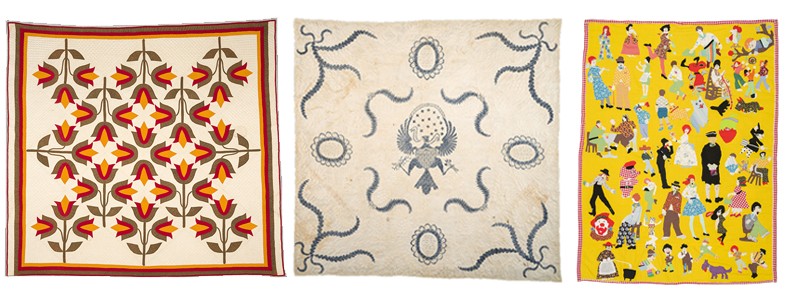Tennessee State Museum to Explore the Art and Story in Tennessee Quilts with New Exhibition
“Between the Layers: Art and Story in Tennessee Quilts” to Open in February, 2019
Image: From left: Dutch Tulip pattern quilt (1897-1902), by Frances Mary “Fannie” Powers, of Rutherford County; Eagle Quilt (1808) by Rebecah Foster; People of the World (1979), by Lillian Beattie, from McMinn and Hamilton Counties. Hi-Res Images Available Here.
NASHVILLE, Tenn. – November 19, 2018 – The Tennessee State Museum’s first new exhibition since its grand opening will be “Between the Layers: Art and Story in Tennessee Quilts.” Slated to open February 8, 2019 and run through July 7, 2019 with quilts selected from the Museum’s vast collection, the show will highlight Tennessee’s quilt artistry and the stories embedded in those quilts, across more than two centuries and all three grand divisions of the state.
One of those stories is Rebecah Foster’s 1808 Eagle Quilt. While little may be known about its creator’s life, the quilt she crafted reveals plenty about her, and the time and environment in which she lived. Foster signed and dated her striking work—the earliest known written date on a Tennessee quilt. The decoration expresses enthusiastic loyalty during a time when U.S. relations with England were strained working up to the War of 1812. The central eagle is a common element in early 1800s decoration. Part of the United States Coat of Arms, it has been updated here to feature 17 stars for the number of states in 1808, instead of the usual 13. Around the eagle are oval frames finely embroidered with the names of the states. Each encloses a patriotic verse.
Producing the quilt was an opportunity for Foster not only to show fervor for her country, but also to express her creativity and show off many talents expected of an educated Tennessee frontier woman—among them needle skills, spinning, and weaving. She follows design fashions of her time, and enhances her quilt with virtuoso appliqué, embroidery and complex quilting. Although the blue printed fabric would have been an imported purchase, the white linen appears to be handspun and handwoven, possibly by Foster herself. Considering that it was made more than two centuries ago, the Eagle Quilt has survived in amazingly good condition, indicating that it was used very little and treasured by generations for both its message and its remarkable artistry.
“Individually crafted quilts are more than just a traditional way to brighten beds and decorate homes,” says Candace Adelson, Tennessee State Museum senior curator of fashion and textiles. “They can also be important outlets for artistic expression. Composed of layers, both physical and metaphorical, a quilt may further hold a wealth of stories—private stories, economic or political stories, stories of changing tastes, and stories and emotions created by the quilts themselves in the memories of we who experience them.”
Other quilts and stories highlighted in “Between the Layers: Art and Story in Tennessee Quilts” include:
- Log Cabin pattern quilt (1865–75), by Jane C. Barnett, made in Shelby or Maury County.
- People of the World (1979), by Lillian Beattie, a quilter of Portuguese and Cherokee descent, from McMinn and Hamilton Counties.
- Double Wedding Ring pattern quilt (1920-35), by African American quilter Harriet M. Falls of Robertson County.
- Dutch Tulip pattern quilt (1897-1902), by Frances Mary “Fannie” Powers, of Rutherford County.
- Rocky Mountain Road pattern quilt (1850-60), by a member of the Bacon Family of Roane County.
- Flower Basket variation pattern quilt (1861-62), by Nancy Isabel “Nannie” Hendricks of Obion County.
“Between the Layers: Art and Story of Tennessee Quilts” will be complemented by a broad range of programming, including events at the Museum, digital initiatives and community outreach. More information about the show and the many quilts on view will be available in the coming months at tnmuseum.org.
About the Tennessee State Museum:
The Tennessee State Museum, on the corner of Rosa L. Parks Blvd. and Jefferson Street at Bicentennial Capitol Mall State Park, is home to 13,000 years of Tennessee art and history. Through six permanent exhibitions titled Natural History, First Peoples, Forging a Nation, The Civil War and Reconstruction, Change and Challenge and Tennessee Transforms, the Museum takes visitors on a journey – through artifacts, films, interactive displays, events and educational programing – from the state’s geological beginnings to the present day. Additional temporary exhibitions explore significant periods and individuals in history, along with art and cultural movements. The Museum is free and open to the public Tuesdays, Wednesdays, Fridays and Saturdays from 10 a.m. – 5 p.m., Thursdays from 10 a.m. – 8 p.m. and Sundays from 1 p.m. – 5 p.m. For more information on exhibitions and events, please visit tnmuseum.org.
Hi-Res Images are available at this Dropbox link.
# # #